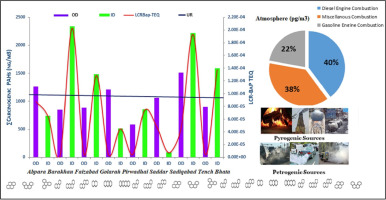Science of the Total Environment ( IF 8.2 ) Pub Date : 2017-11-13 , DOI: 10.1016/j.scitotenv.2017.11.080 Naima Hamid , Jabir Hussain Syed , Muhammad Junaid , Adeel Mahmood , Jun Li , Gan Zhang , Riffat Naseem Malik

|
Due to the severe fuel crisis in terms of natural gas, a paradigm shift in fuel combustion (diesel, gasoline, and biomass) may increase the atmospheric emissions and associated health risks in Pakistan. Present study was aimed to investigate the concentration of fugitive PAHs in the environment (outdoor and indoor settings), associated probabilistic health risk assessment in the exposed population, and possible linkage between fuel consumption patterns and PAHs emissions in twin cities (Rawalpindi and Islamabad) of Pakistan. Results showed that the mean PAHs concentrations (air: 2390 pg m− 3; dust: 167 ng g− 1) in the indoor environment were higher than that of the outdoor environment (air: 2132 pg m− 3; dust: 90.0 ng g− 1). Further, the source apportionment PCA-MLR receptor model identified diesel and gasoline combustion as the primary PAHs sources in the urban and sub-urban settings. Estimated life cancer risk (LCR) potential via inhalation to indoor PAHs was higher with a probability of 2.0 cases per 10,000 inhabitants as compared to outdoor exposure. Incremental lifetime cancer risk (ILCR) model from exposure to dust bound PAHs showed risk in the order of ingestion > dermal > inhalation for various exposure pathways. Likewise, estimated daily intake (EDI) model reflects that PAHs in surface dust enter into the human body mainly through the respiratory system because EDI for breathing was reported higher than that of oral intake. Therefore, adoption of sustainable fuels is recommended to meet the energy requirements and to reduce PAHs emissions and related health risks in the twin cities of Pakistan.
中文翻译:

阐明巴基斯坦多环芳烃(PAH)的城市水平,来源和健康风险:对能源需求变化的影响
由于天然气方面的严重燃料危机,燃料燃烧(柴油,汽油和生物质)的范式转变可能会增加巴基斯坦的大气排放量和相关的健康风险。目前的研究旨在调查环境中(室外和室内环境)中逃逸多环芳烃的浓度,暴露人群的相关概率健康风险评估,以及两个城市(拉瓦尔品第和伊斯兰堡)的燃料消耗模式与多环芳烃排放之间的可能联系。巴基斯坦。结果表明,室内环境中的PAHs平均浓度(空气:2390 pg m -3;粉尘:167 ng g -1)高于室外环境(空气:2132 pg m -3;粉尘:90.0 ng g)− 1)。此外,来源分配PCA-MLR受体模型将柴油和汽油燃烧确定为城市和郊区的主要PAHs来源。与室外暴露相比,通过吸入室内PAHs估计的生命癌症风险(LCR)潜力更高,每10,000居民中有2.0例病例。暴露于粉尘结合的多环芳烃导致的终生终生癌症风险(ILCR)模型显示,对于各种暴露途径,其摄入风险>摄入>皮肤>吸入。同样,估计每日摄入量(EDI)模型反映出表面粉尘中的PAHs主要通过呼吸系统进入人体,因为据报道呼吸用EDI高于口服摄入的EDI。所以,











































 京公网安备 11010802027423号
京公网安备 11010802027423号